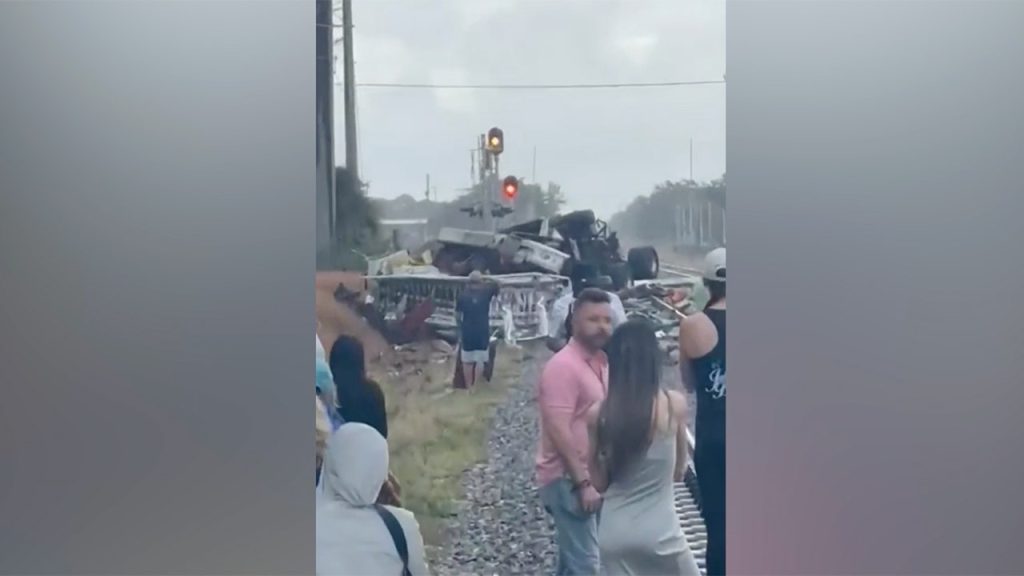The incident involving a Brightline high-speed train and a Delray Beach Fire Rescue ladder truck on a Saturday morning serves as a stark reminder of the potential dangers at railway crossings and the importance of adhering to safety regulations. The collision, occurring near E. Atlantic Avenue and Railroad Avenue in Delray Beach, Florida, resulted in injuries to at least 15 individuals, including three firefighters and twelve train passengers. While the firefighters were transported to a local hospital in stable condition, the passengers sustained minor injuries, underscoring the significant impact of the collision, even at relatively moderate speeds.
The Brightline train involved in the incident was part of the high-speed rail service operating between Miami and Orlando, with intermediate stops in Aventura, Fort Lauderdale, Boca Raton, and West Palm Beach. Delray Beach, the location of the accident, is situated approximately 30 miles north of Fort Lauderdale. The incident prompted immediate responses from multiple agencies, including the Delray Beach Police Department, Brightline, and the National Transportation Safety Board (NTSB), all of which initiated investigations to determine the precise cause of the collision. Preliminary reports suggest that the fire truck may have been attempting to cross the tracks when the train approached, highlighting the potential risks associated with vehicles attempting to navigate railway crossings.
The incident echoes similar events involving trains and vehicles at railway crossings, underscoring the persistent challenges in ensuring safety at these intersections. A separate incident involving a train colliding with a military mobile artillery vehicle hauled on a semi-truck further emphasizes the potential for severe consequences when vehicles and trains intersect. While the specific details of this separate incident are yet to be fully disclosed, it reinforces the need for heightened awareness and caution around railway crossings, particularly for large vehicles and those transporting potentially hazardous materials.
The frequency of such accidents underscores the inherent risks at railway crossings, where the convergence of high-speed trains and vehicular traffic creates a potential for devastating collisions. The incident involving the Brightline train and the fire truck highlights the importance of adhering to safety regulations and exercising extreme caution when approaching railway crossings. The fact that the fire truck, a vehicle typically associated with emergency response and adherence to safety protocols, was involved in the collision, further emphasizes the need for constant vigilance and strict adherence to traffic laws at these crossings.
Brightline’s statement following the incident, emphasizing that “railroad safety is a community-wide effort,” underscores the shared responsibility for preventing such accidents. The company’s admonition to “never drive around crossing gates when they are down” serves as a crucial reminder of the fundamental safety protocol at railway crossings. This simple yet critical rule, if universally observed, could significantly reduce the number of accidents at these intersections. The incident reinforces the importance of public awareness campaigns and educational initiatives to promote safe practices around railway crossings, targeting both drivers and pedestrians.
The ongoing investigations by the Delray Beach Police Department, Brightline, and the NTSB will provide a comprehensive understanding of the factors contributing to the collision. This information will be crucial in developing targeted safety measures and preventing similar incidents in the future. The investigations will likely examine various aspects, including the actions of the train operator, the fire truck driver, the functionality of the crossing signals, and any other contributing factors, such as visibility or environmental conditions. The findings of these investigations will not only inform immediate safety improvements but also contribute to broader strategies for enhancing railway crossing safety nationwide. The focus on rail safety should extend beyond immediate responses to incidents and encompass proactive measures, including infrastructure improvements, technological advancements, and public awareness campaigns, to create a safer environment for both train passengers and the communities through which these trains operate.

